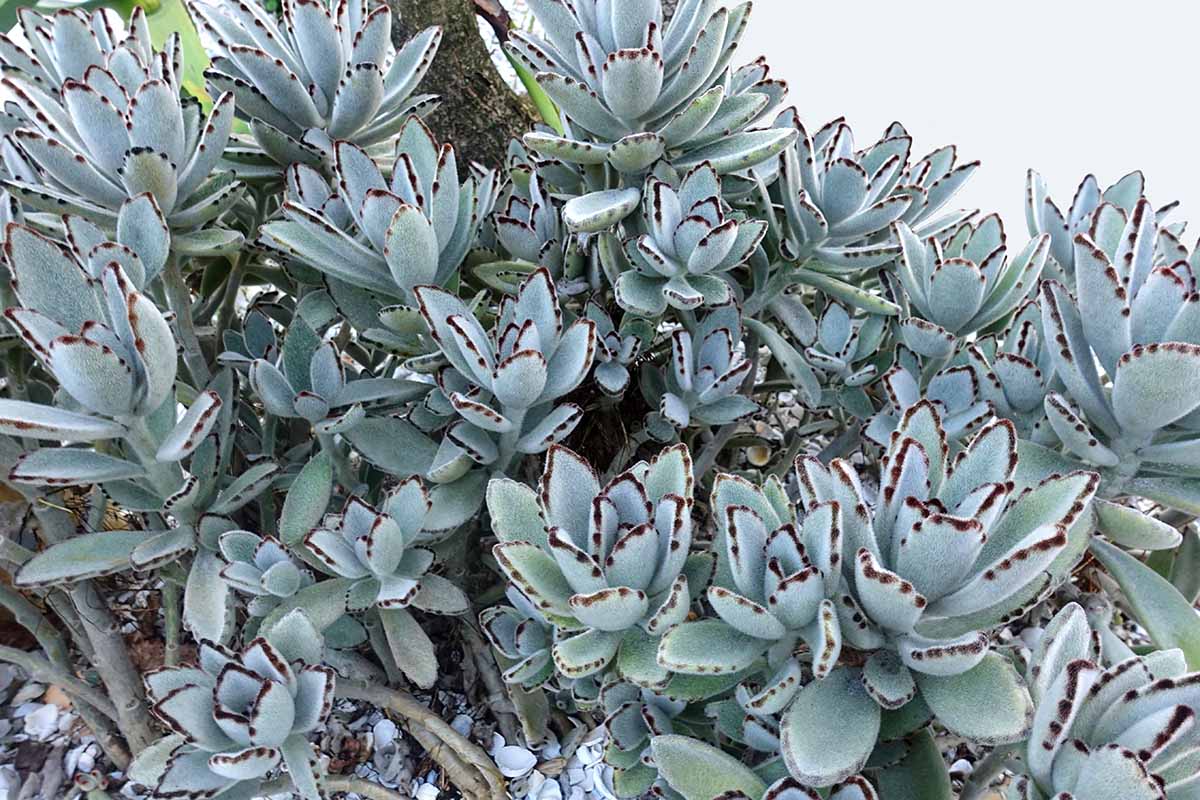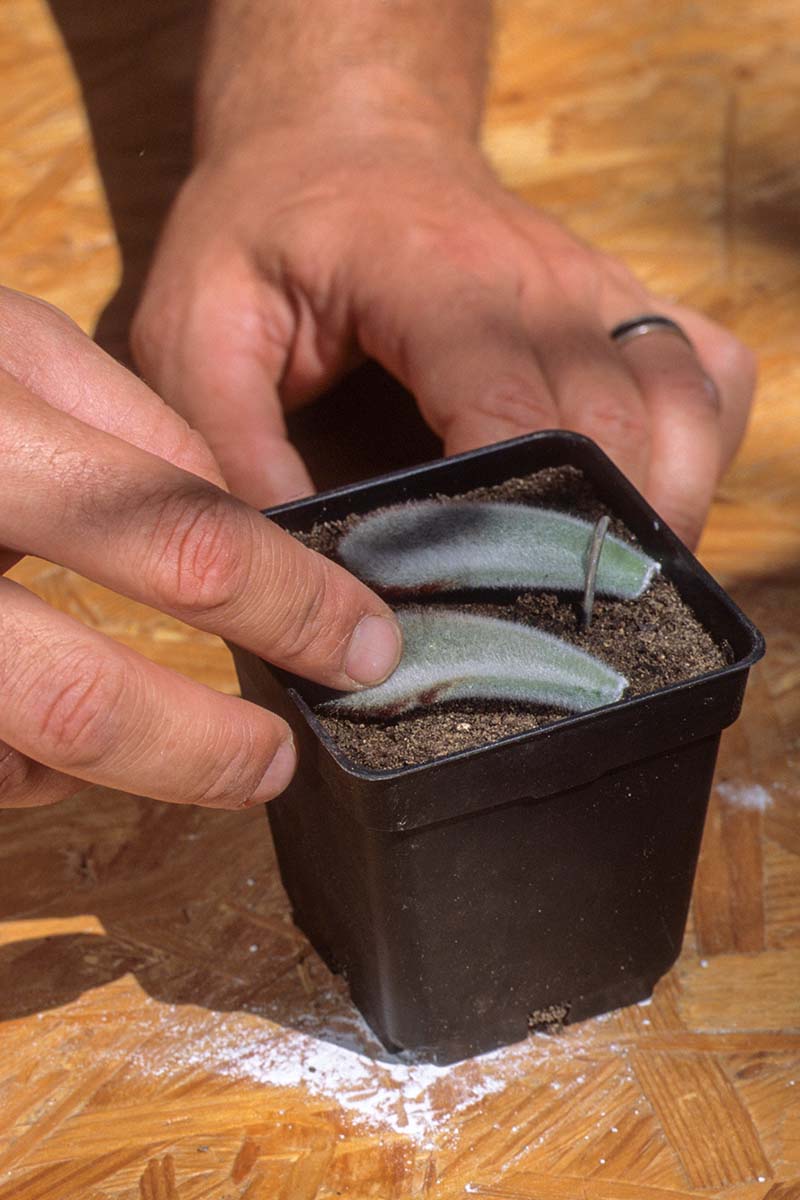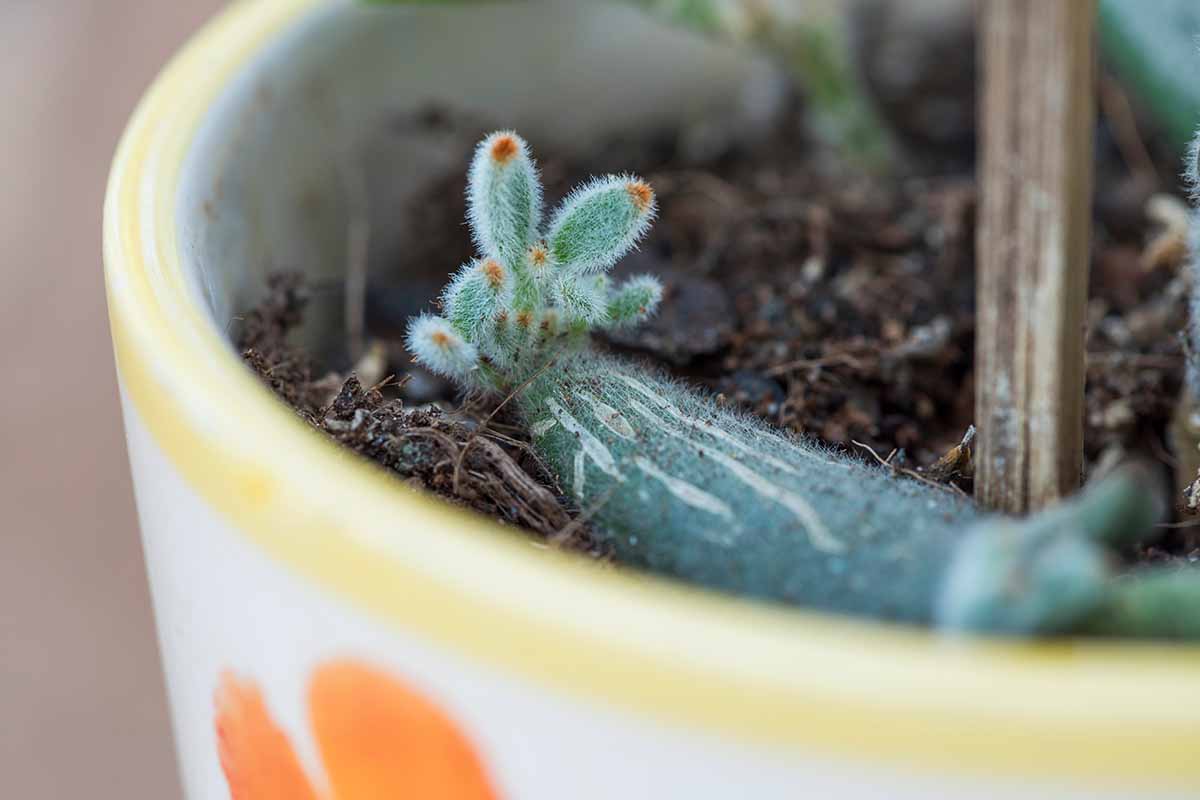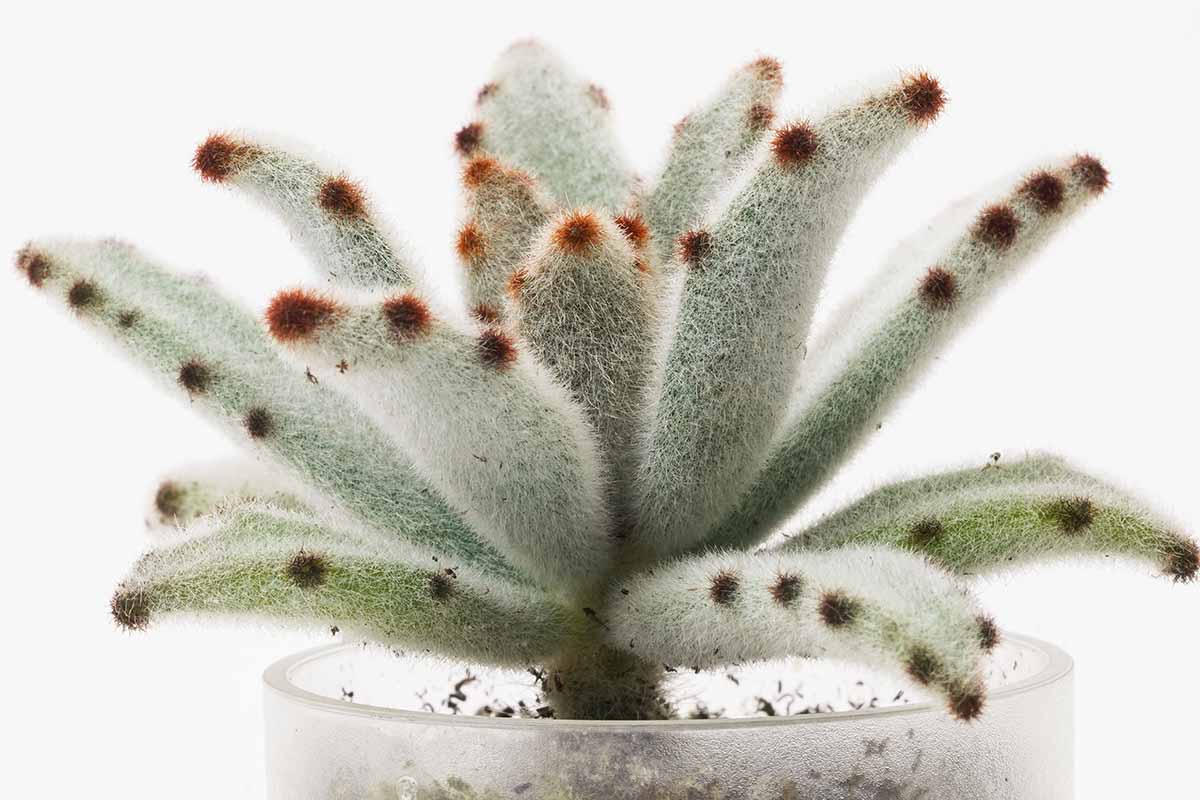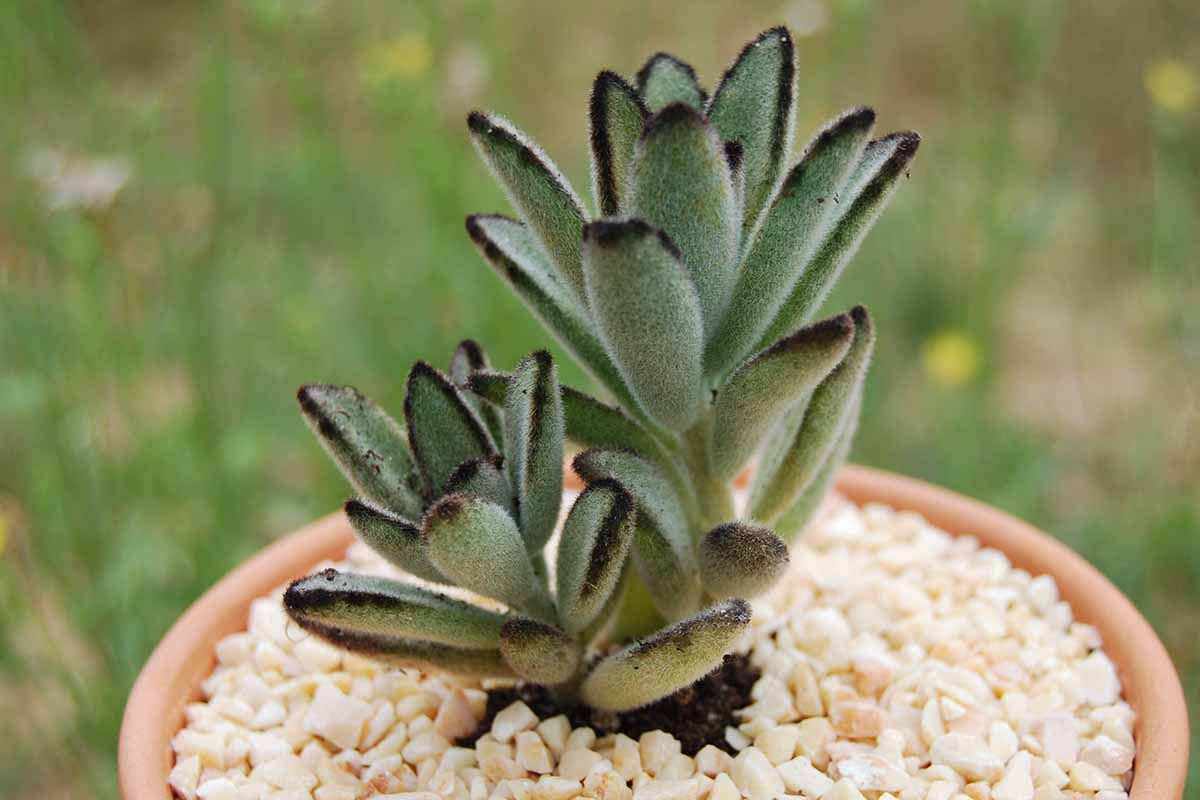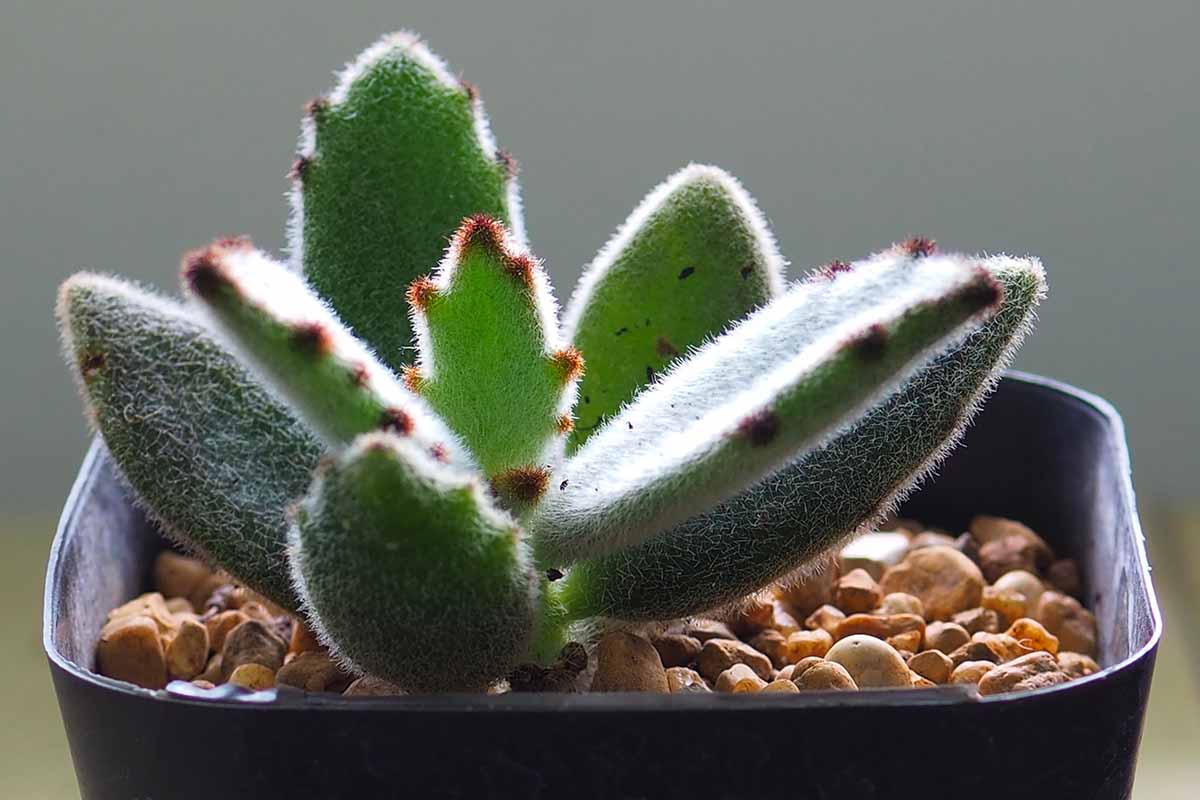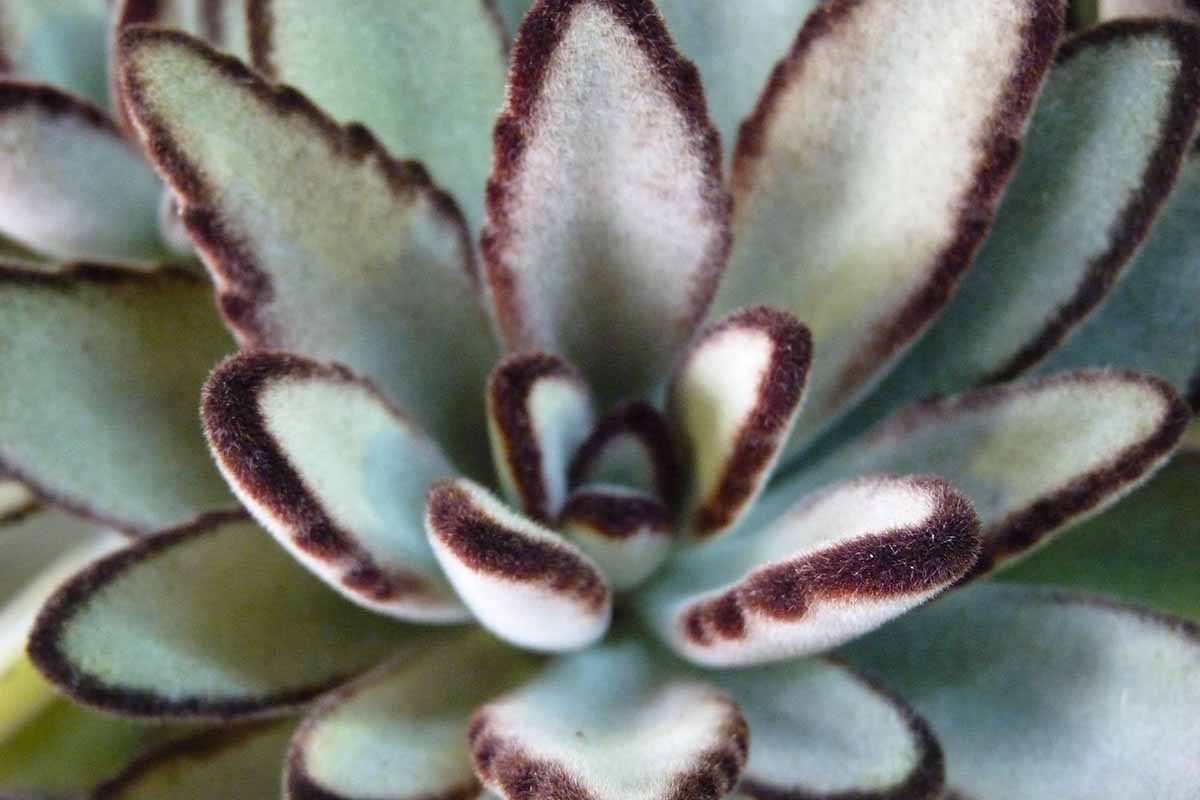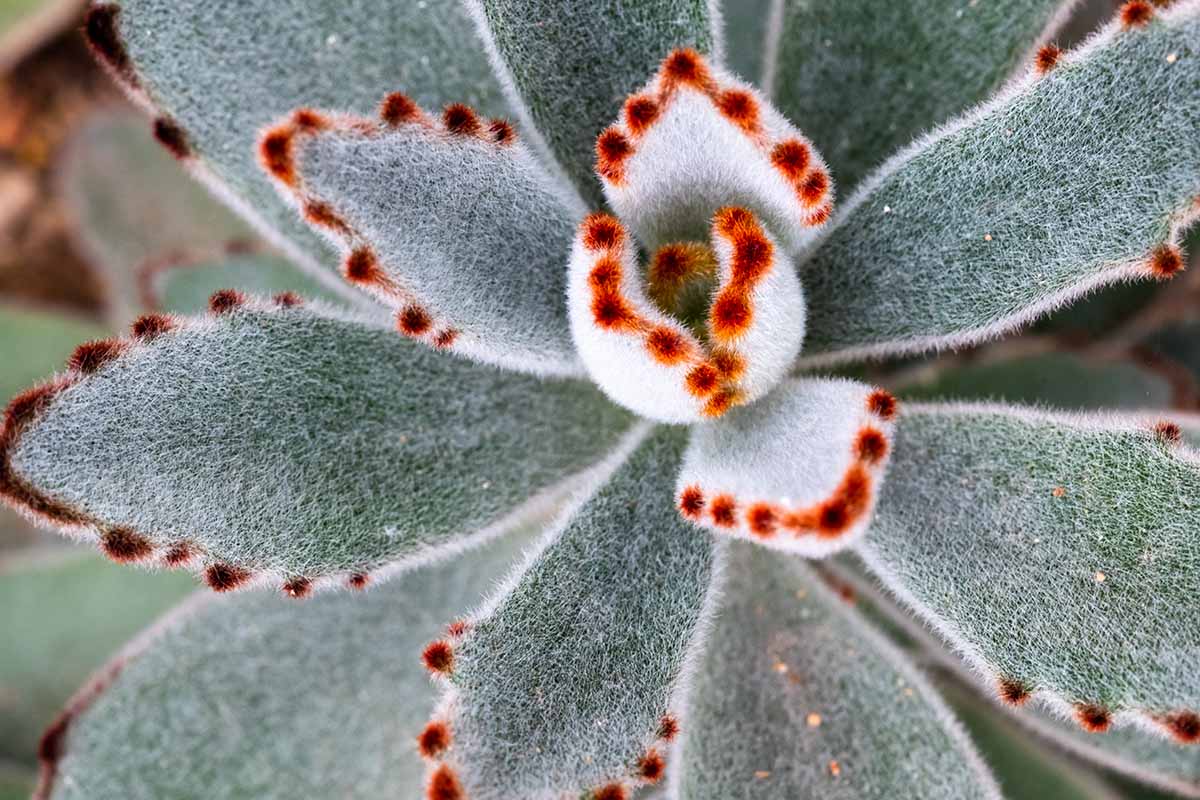We link to vendors to help you find relevant products. If you buy from one of our links, we may earn a commission. Read on to learn how to grow a panda plant indoors. Here’s a preview of the topics we’ll cover: Get ready for a new addition to your indoor garden family.
What Is a Panda Plant?
Panda plant, aka pussy ears and stitch plant, is a member of the widespread Kalanchoe genus and is native to the mountains of central Madagascar, where it grows in granite outcroppings. In this temperate setting, the warm, rainy summers have daytime highs in the 80s, while in the cool, dry winters, highs are in the 60s. It has an upright, branching growth habit, and soft, fine hairs called “trichomes” cover the blue-green leaves. This protective covering insulates against temperature extremes, aids moisture retention, and creates a fuzzy look and feel. The leaves are elliptical with reddish-brown dots and bands along the margins. And while indoor succulents may not bloom, when grown outdoors, K. tomentosa produces panicles of tubular yellow blossoms in early spring and into the summer. Mature heights in the wild range from one to three feet, and widths are from two to three feet. Indoor cultivation may result in reduced stature. This slow-growing species multiplies by producing offsets. And like the Christmas cactus, the stems are likely to become woody with age. K. tomentosa was a 1993 recipient of the Royal Horticultural Society (RHS) Award of Garden Merit (AGM), a testament to its reliable value for the home gardener.
Propagation
This succulent species is easy to propagate. You can take a leaf or stem cutting, divide an offset, or purchase a potted plant from a nursery to get started. However, they stress that consuming this plant may cause vomiting and pose a choking hazard. Do not eat any part of this plant and keep pets and children away from it.
Our guide to propagating succulents has full details. Let’s take a quick look at each method.
From Leaf Cuttings
The best time to take a leaf cutting is during active spring growth. Begin by pinching off a leaf at the base. Fill a shallow container with cactus and succulent potting medium and lay the leaf or leaves on top. In a day or two, the cut end will form a hard, dry callus from which new foliage and roots will sprout over the next few weeks. Keep the cutting dry during this time.
From Stem Cuttings
Another way to begin is by taking stem cuttings in the spring. Instead of pinching off an individual leaf, use clean, sharp pruners to cut a stem about an eighth of an inch below a leaf node, a natural growing point. Lay the stem on its side on a paper towel and keep it dry. Allow the cut stem to dry out and form a hard callus before transplanting.
Divide an Offset
To divide offsets, use a clean, sharp hori hori knife to sever the roots that connect the parent to an offset. Transplant the division immediately. If the parent plant or the offset shows signs of pest infestation or disease, rinse the soil off the roots and examine them for signs of damage, desiccation, discoloration, or rotting. Cut off any unhealthy roots and let the remaining roots dry completely before transplanting the salvaged healthy divisions.
From a Nursery Pot
If you purchase a potted plant, you can transplant it to a new container of your choice. Choose a pot that is porous and well-draining. Set the plant at the same depth it was in its original container. There should be half an inch to an inch of room between the pot rim and soil surface for watering without soil overflow. Avoid planting too deeply as it may impair evaporation and promote rotting.
How to Grow
In the wild, K. tomentosa thrives in full sun to part shade. The soil is rocky, comprised primarily of granite, with a slightly acidic pH of 5.5 to 6.0. To transplant offsets, rooted cuttings, or nursery starts, set them at the same depth as in the original container and backfill with potting medium for a firm hold. Avoid drafts and wide temperature fluctuations that may cause stress to the plant and stunt its growth. Replicate the well-draining, gritty soil of its natural habitat with a quality cactus and succulent potting medium. One you may like to try is Tank’s-Pro Cactus and Succulent Mix. Tank’s-Pro Cactus and Succulent Mix With coconut husk chips, horticultural pumice, and organic compost, you’ll have the exceptional drainage required for successful succulent cultivation. For best results, choose a porous pot made of a material like clay. It should be one inch wider than the foliage to allow room for a watering can spout. There should be one or more drainage holes in the bottom and you will need a drip-catching dish or saucer to place underneath. Water using the “dry and soak” method, waiting until the pot is completely dry before giving the soil a thorough soaking. Allow excess water to drain out before returning the pot to its dish to avoid standing water that may lead to fungal infection and rotting.
Growing Tips
Like most succulents, a panda plant is easy to cultivate when you:
Provide bright indirect sunlight in a temperate room.Use well-draining cactus and succulent potting medium.Transplant at the same depth as in the original container.Use the dry and soak watering method.Avoid standing water.
Now let’s talk about a few simple maintenance chores.
Maintenance
Over time, potted flora depletes the soil of its nutrients. Restore them by fertilizing once in the spring and once in the summer with a liquid cactus and succulent food diluted to half strength. Repot every few years as needed to accommodate expansion. A snug fit is best, as it keeps the root sprawl from outpacing the leaf growth. There should be an inch of space between the foliage and the pot rim for easy watering. Water with the soak and dry method. Use a moisture meter as your guide and reduce watering during winter dormancy. Monitor for signs of pests and diseases that may require prompt treatment. We’ll discuss these shortly, but first, let’s look at available purchase options.
Managing Pests and Disease
Pests do not generally plague succulents, but there are two to watch out for: Panda Plant, K. tomentosa In addition to the species plant, there are a few named cultivated varieties with unique features you may like. Here are a couple of options to consider:
Chocolate Soldier
K. tomentosa ‘Chocolate Soldier’ is a cultivated variety, which features more pointed leaf tips and dark brown, almost black edging. ‘Chocolate Soldier’
Golden Girl
K. tomentosa ‘Golden Girl’ warms up the foliage, taking it from a cool blue-green to a warm yellow-green, while preserving the classic reddish-brown margins and elliptical leaves.
AphidsMealybugs
Read our guides to learn more about these pests and for avoidance and eradication measures. There are also diseases to be aware of, including:
Cactus Root RotPowdery Mildew
Cactus root rot is caused by Phytophthora cactorum, a fungal-like pathogen classified as a water mold (oomycete). It undermines the roots and causes brown foliar discoloration and deformity. There are phosphonate fungicides on the market for treating infections caused by water molds, but once the soil is infected and the roots begin to rot, there is little hope of recovery. Your only option is to dispose of the plant and the soil it was growing in, and start again. Consult our guide to powdery mildew to learn more about this fungal disease.
Best Uses
The fuzzy texture and prominent brown outlining on the leaves make K. tomentosa a striking addition to your indoor garden, whether you’re growing it as a standalone specimen or in a mixed succulent grouping. You might use panda plant decoratively as a soft and curving contrast to the sharp angles of a contemporary glass, metal, or wood table. Choose growing companions like bromeliads, cacti, and other succulents with similar cultural requirements for a showy collection. With well-draining soil, bright indirect sunlight, spring feeding, and soak and dry watering, you can rest assured you’ll fulfill its cultural requirements. Primed for success, you’re ready to introduce this texturally-rich two-tone attraction to your indoor garden family. Do you grow panda plants? Tell us about it in the comments section below. If you enjoyed this article and want to learn about other succulent houseplants, we recommend the following guides next:
35 of the Best Hanging and Trailing Succulents and Cacti How to Grow and Care for Haworthia IndoorsHow to Grow and Care for String of Pearls

